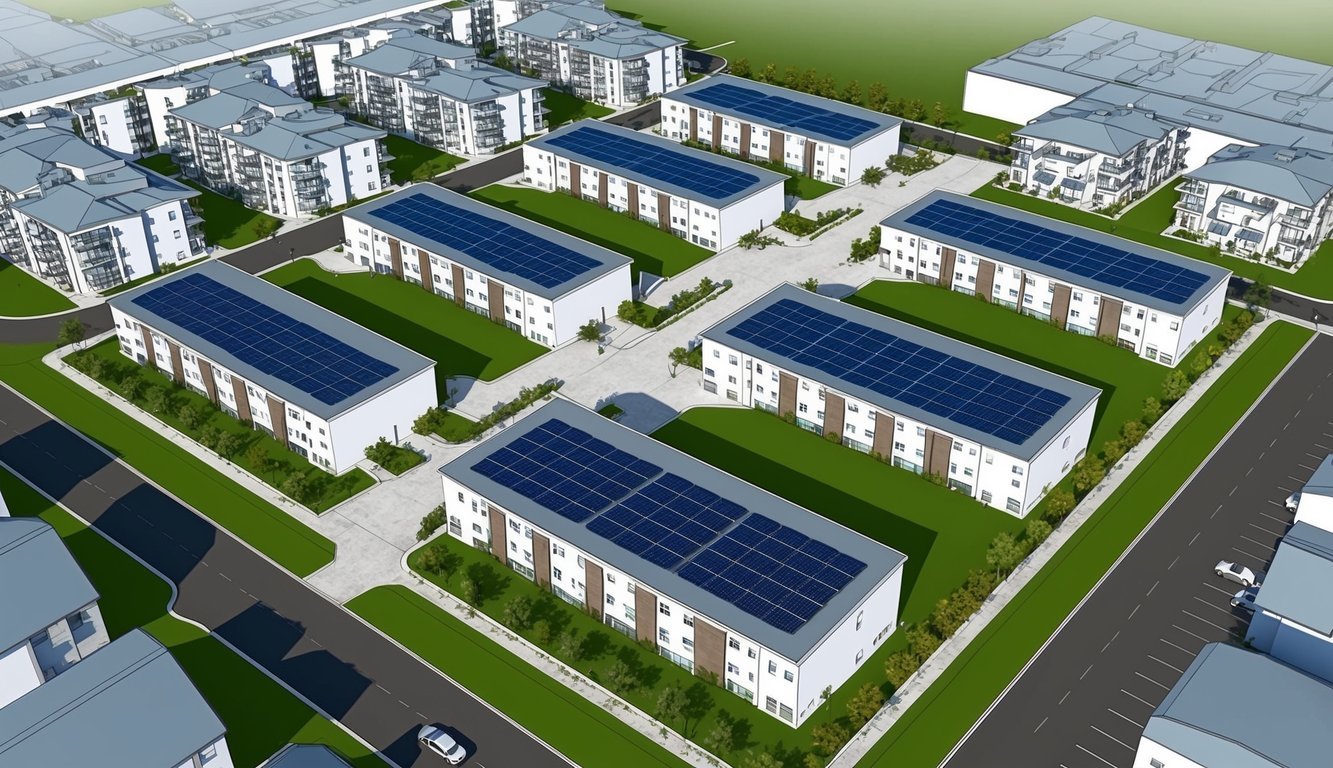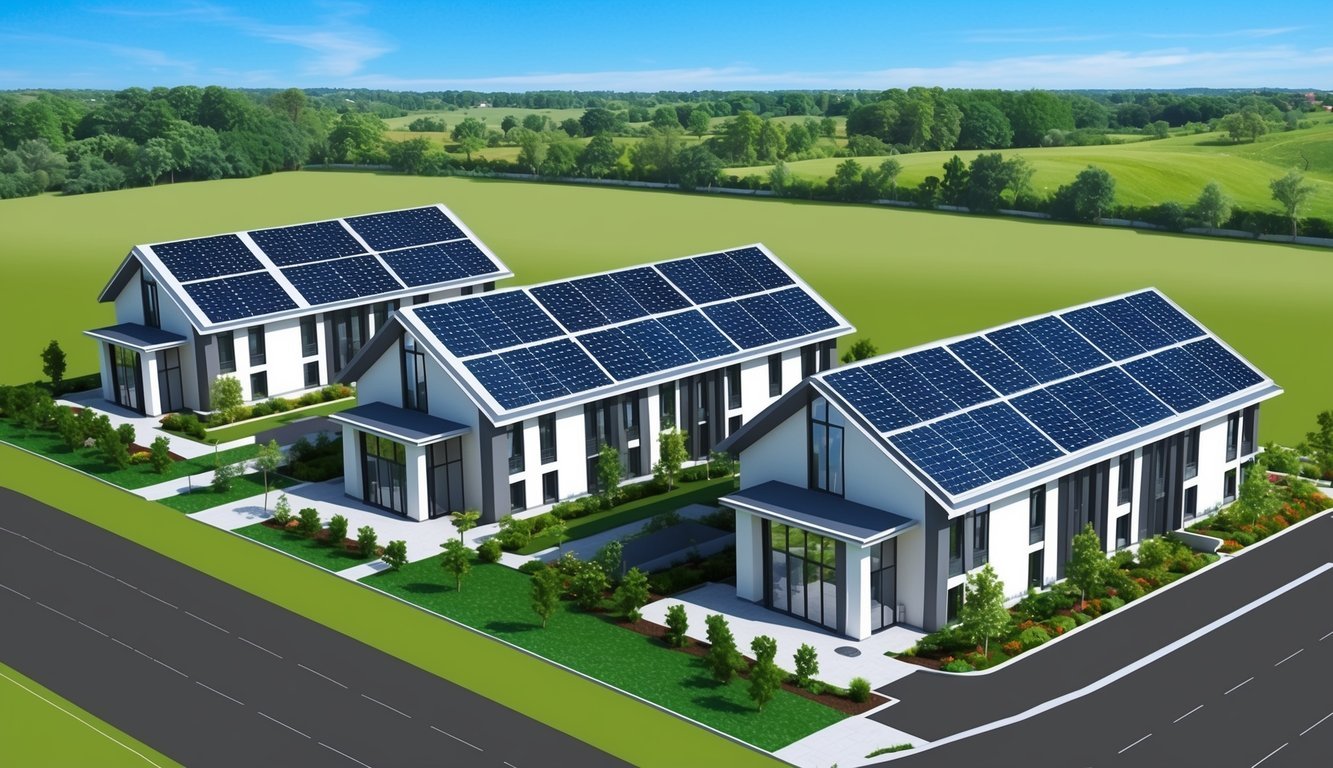Navigating the world of real estate developments can be a complex task.
This is especially true when considering sustainable options such as solar panel systems.
As the demand for eco-friendly solutions increases, understanding how solar energy can enhance property value becomes crucial.

Incorporating solar panel systems into real estate developments not only reduces energy costs but also appeals to environmentally conscious buyers. This growing interest in renewable energy impacts how homes are designed, marketed, and sold.
Recognizing these factors can position you to make informed decisions about integrating solar technology into your projects.
1) Tesla Solar Roof

The Tesla Solar Roof offers an innovative solution for incorporating solar energy into real estate developments.
This system seamlessly integrates solar technology with a sleek roofing design, providing a functional and aesthetically pleasing option for new or existing properties.
With its architectural appeal, the Solar Roof is designed to blend with various building styles.
Each tile captures solar energy, contributing to sustainable power generation without compromising on appearance.
This makes it an ideal choice if you’re looking to enhance the value and eco-friendliness of your real estate projects.
You can pair the system with Tesla’s Powerwall, which provides reliable energy storage.
This combination ensures energy efficiency and helps mitigate the impact of power outages.
With remote monitoring available via the Tesla app, managing your energy system becomes convenient and efficient.
Typically, installation times for the Solar Roof range from five to seven business days, although this may vary depending on roof size and complexity.
This timeframe allows for planning around project schedules and deadlines.
For more detailed information about installation, visit the Solar Roof Installation Process.
2) SunPower Equinox
The SunPower Equinox system is a key asset for real estate developments focusing on sustainable energy solutions.
Its design integrates aesthetic appeal with efficiency, making it ideal for modern architecture.
Equipped with Maxeon solar technology, the system ensures high conversion efficiency, reaching up to 22.8% in some models.
This means more electricity generated from less roof space, a valuable feature for developers.
The system includes built-in microinverters, which optimize power conversion and eliminate the need for bulky external units.
This feature enhances the streamlined look of properties while ensuring efficient energy use.
InvisiMount hardware offers a sleek design by hiding components, allowing the solar panels to blend seamlessly with any building’s architectural style.
This can be a persuasive selling point for prospective buyers interested in clean energy.
The SunPower Equinox system also supports the addition of energy storage units.
This provides backup power capabilities, adding value in regions prone to power outages.
Real estate professionals can find SunPower’s solutions backed by robust warranties.
This gives developers and buyers peace of mind, knowing there is reliable support from a trusted industry leader.
3) LG NeON R

The LG NeON R solar panels are an excellent choice for enhancing the value of real estate developments.
These panels feature a back contact structure, which maximizes light utilization.
This design not only boosts efficiency but also enhances durability, making them a reliable option for long-term use.
When considering the financial aspects, these panels come with an impressive 25-year product and labor warranty.
The guarantee covers significant aspects such as product performance, ensuring a sustained power output over the years.
This makes the NeON R an attractive investment for property developers looking to ensure a lasting impact.
For developments in warmer climates, the NeON R is particularly beneficial.
Its high performance in hot weather conditions ensures consistent energy production, regardless of temperature fluctuations.
This capability can be crucial for properties in regions with strong sunlight exposure throughout the year.
Additionally, LG’s commitment to quality assurance is evident in its industry-leading warranty programs.
The confidence that LG places in its products is a testament to the innovative and efficient design of the NeON R, which stands out as a top option in the solar panel market.
Benefits of Solar Panels in Real Estate Developments

Integrating solar panels into real estate developments can lead to numerous advantages.
These include significant cost savings and improved returns on investment, a reduced environmental footprint promoting sustainability, and the ability to attract tenants who prioritize eco-friendly living.
Cost Savings and Return on Investment
Investing in solar panels can significantly reduce operations and maintenance costs.
As a real estate developer, you benefit from decreased electricity bills due to the shift from traditional grid electricity to renewable solar energy.
This financial advantage often outweighs the initial investment over time.
Moreover, government incentives and tax credits can further enhance your return on investment.
You may also discover increased property value, enabling higher sale prices or rental rates compared to conventional buildings.
Environmental Impact and Sustainability
Solar energy reduces the carbon footprint of any building, which is a crucial step toward sustainability.
Utilizing renewable resources ensures energy independence, contributing to a cleaner environment by reducing reliance on fossil fuels.
This can be pivotal in meeting regulatory standards or certifications for green building.
Sustainable properties are increasingly in demand as environmental awareness grows, presenting real estate developments with another opportunity to stand out in the market.
Attracting Eco-Conscious Tenants
Today’s tenants often seek residences that align with their values, which increasingly includes sustainability.
Offering solar-powered homes or offices can be a unique selling point, attracting those who prioritize eco-friendly living.
Eco-conscious tenants tend to value the cost-efficiency and environmental benefits of solar energy.
This added appeal not only helps in retaining tenants but can also justify premium rental rates, enhancing the property’s financial attractiveness.
Types of Solar Panel Systems for Real Estate Projects

Implementing solar panel systems in real estate developments can offer sustainable energy solutions, cost savings, and increased property value.
This section outlines three key types of solar systems suitable for real estate projects, each with unique characteristics and benefits.
Photovoltaic (PV) Solar Panels
PV solar panels convert sunlight into electricity, making them one of the most popular options for real estate developments.
These panels are typically installed on rooftops to produce clean energy and reduce reliance on conventional power sources.
PV systems are available in various forms, including monocrystalline and polycrystalline panels, each offering different efficiency levels.
Monocrystalline panels, known for their high efficiency, can occupy less space compared to other types.
Incorporating PV solar panels in your real estate projects provides the dual benefits of energy efficiency and environmental responsibility.
Cost savings on energy bills can also enhance the appeal and value of your properties.
Solar Hot Water Systems
Solar hot water systems generate heat using energy from the sun, providing an efficient method for heating water in residential and commercial properties.
These systems typically consist of solar collectors, a storage tank, and a heat transfer system.
The two main types include active systems, which use pumps and controls, and passive systems, which rely on gravity and natural circulation.
Solar hot water systems can significantly decrease energy consumption for water heating, a substantial expense in real estate developments.
Installing solar hot water systems can offer sustainable heating solutions while reducing the carbon footprint and energy costs, crucial factors for modern real estate endeavors.
Concentrated Solar Power Systems
Concentrated Solar Power (CSP) systems utilize mirrors or lenses to concentrate a large area of sunlight onto a small area, generating heat to produce electricity.
CSP systems are typically used in large-scale settings but can be adapted for certain real estate projects that require substantial energy output.
Although less common than PV solar panels for real estate, CSP systems can be valuable for projects with specific energy demands.
These systems can be integrated into mixed-use developments or commercial properties where enhanced energy capabilities are necessary.
By leveraging CSP technology, you can achieve higher energy generation, which may contribute to the overall efficiency and sustainability of your development projects.
Installation and Maintenance Considerations

When planning to integrate solar panel systems in real estate developments, evaluating both installation and maintenance is crucial.
Careful site assessment ensures optimal performance, while understanding maintenance needs helps preserve system longevity.
Site Assessment and Feasibility
Assessing the site is the first and most crucial step in solar panel installation.
You must evaluate the location for adequate sunlight exposure, considering any potential obstructions like trees or buildings.
Geographic and climatic factors in the area should also impact your decision, as they affect solar panel efficiency.
The structural integrity of the roofs or surfaces intended for installation must be examined.
Panels require sturdy support, especially in areas prone to strong winds or heavy snowfall.
Additionally, checking local zoning and building codes ensures compliance with regulatory requirements.
Early consideration of these factors can prevent costly redesigns.
Maintenance Requirements and Longevity
Regular maintenance is essential for the optimal functioning of solar panel systems.
Cleaning the panels, especially in areas with high pollution or dust, helps maintain their efficiency.
Scheduled inspections to check for any physical damage, electrical issues, or shading are also vital.
The longevity of most panels ranges from 25 to 30 years.
However, monitoring performance over time for efficiency declines can guide replacement decisions.
Having a maintenance plan in place, which might include remote monitoring systems, ensures any issues can be addressed promptly.
By dedicating attention to these aspects, you enhance the reliability and lifespan of your investment.
Frequently Asked Questions

When considering solar panel systems for real estate development, you must evaluate factors such as compliance with state mandates, cost impacts, and system suitability for the type of construction.
The following sections cover the most pertinent questions you may have concerning these areas.
What are the key factors in selecting a solar panel system for real estate development projects?
Selecting the right solar panel system involves examining efficiency, cost, brand reputation, and specific state regulations.
For instance, the Tesla Solar Roof, known for its integrated solar and roofing solution, offers high efficiency and aesthetic appeal but may come with a higher upfront cost.
How do the California Title 24 solar requirements impact real estate developments?
California Title 24 significantly influences how you plan real estate projects by mandating solar installations on new homes.
This requirement ensures energy efficiency and sustainability but may increase initial project expenses.
Understanding these regulations can assist you in planning your developments accordingly.
What are the cost implications of installing solar panel systems in real estate developments?
Installing solar panel systems can involve upfront costs for equipment and installation.
Over time, these systems provide savings on energy bills and potential tax incentives.
For instance, systems like the SunPower Equinox offer high efficiency and can lead to faster return on investment.
Are there exemptions to the California solar mandate for real estate developments?
While the California solar mandate is comprehensive, there are certain exemptions.
For developments where solar access is unavailable or impractical, you might be eligible for a waiver.
It’s crucial to consult with local authorities to confirm if your project qualifies for any exemptions.
What types of solar panel systems are most suitable for new home constructions?
For new constructions, choosing an integrated system like the Tesla Solar Roof or high-efficiency panels like the LG NeON R could be ideal.
These systems offer compatibility with modern home designs and superior energy production, making them suitable choices.
How do solar panel system requirements vary across different regions in California?
System requirements can vary across different regions in California.
Regional differences such as weather patterns and local ordinances can impact these requirements.
In some areas, building codes may dictate specific panel types or configurations.
Familiarizing yourself with local guidelines will help ensure compliance and optimize system performance in each region.

